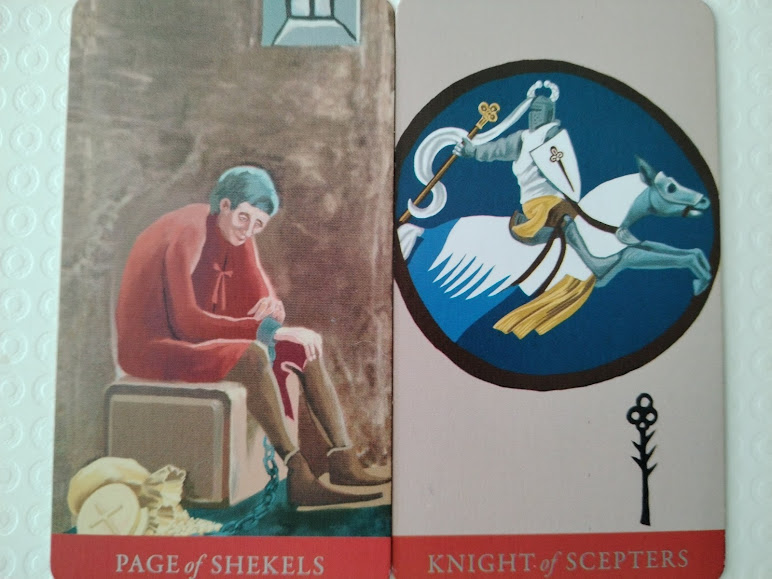The history of Tarot Médiéval reads like an adventure novel. It was a French Tarot originally written by Francis Rolt-Wheeler and artist Christian Loring but published in the fateful year of 1939. Following the fall of France in June 1940, it seems not to have survived, and few copies of the original remain. Caitlín Matthews has translated and edited Rolt-Wheeler’s text and written new material for this beautiful Tarot, whose art has been painstakingly restored by renowned artist Wil Kinghan. Tarot Médiéval has a luminous, dreamlike, medieval setting, with fully illustrated 22 Major Arcana, 16 Court Cards, and 40 Pip cards in the suits of Cups, Swords, Scepters (Wands), and Shekels (Coins). Each card explores the symbolic, initiatic, Kabbalistic, numerological, astrological, and divinatory significances, to nourish the spiritual life. The historical and magical context of this extraordinary deck is rooted in the Oswald Wirth school of Tarot, and Caitlín has provided new ways of using the cards that give meditational paths to explore it in a deeper way. This is a Tarot whose time has come, and an inward adventure of a lifetime is waiting in the cards.
Card dimensions: 2 1/2" x 4 1/2"
Reveals the magical life of the Tarot between the Waite-Smith deck and the modern Tarot boom to charm the reader with the chivalry and adventure of the Middle Ages while providing new ways of reading and considering Tarot
A Tarot to meditate on and grow with that is designed for readers of any level who wish to enhance their understanding of what Tarot can be
Previously lost to history through conflicts in the 20th century, this Tarot is now restored to the world through the tireless efforts of the deck’s creators.
Tarot Médiéval is available now from Schiffer/REDFeather. You can see the unboxing and silent flickthrough videos on Tiktok.
This deck has possibly the coolest box I've ever seen; the top opens in two flaps, held closed magnetically at the centre. It's a brilliant start to this wonderful package.
The LWB - and the images themselves - are a translation of a deck first published in 1939, in France. The images have been redrawn from photos of the original deck. The meanings and descriptions delve quite heavily into Kabbalistic and other divinatory methods, which were very much in vogue at the time. The LWB starts with Caitlín's introduction, then the original introduction, and then we're straight into the Majors, starting in this deck with the Magician.
Each Major has three pages; an image of the card with a symbol and Hebrew letter; a description of the image; some symbolic information, which I found I had to work at, but I haven't done much in the way of correspondences yet; and the upright and reversed meanings of the card.
The next chapter is for the Minor Arcana, described as the Four Temples. This deck alters what we'd think of as the 'usual' elemental correspondences, with Scepters/Wands as Air and Swords as Fire. The book goes into some detail about the Court cards in general, and then moves into the card meanings. Minor cards have about half a page each, with a small image of the card, a description and the meanings upright and reversed.
After the meanings there's a chapter on the history of the deck, drawing in the wider history of Tarot and how it ties in to Kabbalah and other methods. There's a lot of information here and I've only skimmed the surface yet, but I'm looking forward to studying it in detail! Following that chapter there's some spreads and the history of reading spreads, which was really interesting to read. It also gives some sample spreads and meanings, which I always enjoy - it's great fun testing myself against the book!
Now, the cards. Before we get into specifics, note that this is a pip deck, and the design means that some cards don't have an 'upright' or 'reversed' - they look the same either way around. Cups are safe as they obviously have an 'up' and 'down'; some Scepters (Wands) do and some don't; the Swords are mostly interchangeable; the Shekels (Pentacles) could be either. If you don't read reversals, this won't matter to you, but if you do it's something to be aware of.
The cards feature this reversible back design:
Majors have their name printed along the bottom, with Roman numerals; the Magician is I, Justice is at VIII, Strength at XI and the Fool at XXI, with the World at XXII. Minors have their numbers, in Arabic, in the top left and lower right corners, like playing cards. Minor suits are colour coded, Scepters (Wands) in blue, Swords in red, Cups in green and Shekels (Pentacles) in brown. Courts and Aces also have their names across the bottom.
To my eyes, the art has a religious air - one of my Querants thought that the Ace of Cups looked like a First Communion medal, and I can't argue!
They're very beautiful images, though, and I've enjoyed studying them as I work with the deck. Here are some samples:
I always tend to think that pip decks are not the best for beginners, but as soon as a Reader had the basics down this would be a great deck to continue with. There's a lot to be learned here and very beautiful cards to learn it with.
My Querants found the readings mostly positive, which is nice; nothing that made them gasp at the accuracy but nothing that seemed completely impossible either. One said that the pips seemed like they came from a different deck than the beautiful Majors! Everyone enjoyed the readings, though, and I have enjoyed working with this deck - I look forward to studying it in more detail and learning about my correspondences and deeper meanings!














💖
ReplyDelete